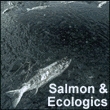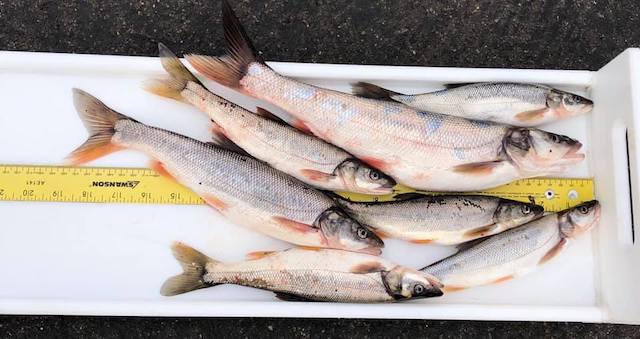forum
library
tutorial
contact

Get Paid for Fishing the Columbia and Snake.
2024's Top Earner Made $164,000
by Annette Cary
Tri-City Herald, April 30, 2025
|
the film forum library tutorial contact |

|
Get Paid for Fishing the Columbia and Snake.
by Annette Cary
|
Tagged fish aren't just a bonus for anglers.
They're a critical tool for tracking the program's success
 Richland, WA -- The bounty program that pays anglers for turning in northern pikeminnow caught on the Columbia and Snake Rivers opens for the 2025 season on Thursday, May 1.
Richland, WA -- The bounty program that pays anglers for turning in northern pikeminnow caught on the Columbia and Snake Rivers opens for the 2025 season on Thursday, May 1.
Recreational anglers earn up to $10 per eligible fish they catch and turn in, with some tagged fish worth hundreds of dollars.
But some Tri-Cities area residents got a jump on the program as Washington state Fish and Wildlife opened the season 10 days early near the Tri-Cities. Several hundred pikeminnow have already been turned in for payment at both the Columbia Point station in Richland and the Umatilla boat ramp on the Columbia River in Oregon.
The early opening allowed anglers to take advantage of favorable water conditions and the prime fishing window for pikeminnow. The best fishing in the Tri-Cities area is usually in the spring, continuing through much of June.
On Thursday the season opens at more stations for pikeminnow caught from the mouth of the Columbia River upstream to Priest Rapids Dam in Grant County and on the Snake River from its mouth from south of Pasco upstream to Hells Canyon Dam.
Northern pikeminnow are native to Washington and Oregon, but they are voracious predators of juvenile salmon and steelhead.
"Since 1991, anglers have logged more than a million trips and removed nearly 6 million northern pikeminnow from the Columbia and Snake Rivers -- reducing predation on young salmon by up to 40% compared to pre-program levels," said Eric Winther, program manager with the Washington Department of Fish and Wildlife.
Registration for the Northern Pikeminnow Sport-Reward Fishery is required before fishing each day, and only pikeminnow that are at least 9 inches qualify for the program.
The goal is not to eradicate northern pikeminnow, but to remove 10% to 20% of the larger, predator-sized northern pikeminnow each year. That helps shift the population toward smaller pikeminnow, which consume fewer salmon and steelhead smolts.
Pay per qualifying pikeminnow is $6 for the first 25 fish, $8 for subsequent fish caught up to 200 and then $10 for every fish after that.
The program also includes specially tagged northern pikeminnow worth up to $500 each.
This year $200 payments will be made if pikeminnow have a PIT, or passive integrated transponder, tag when they are turned in at registration stations.
The $500 bonus fish have an external tag that anglers can see, but PIT tags are inside the fish.
"Tagged fish aren't just a bonus for anglers. They're a critical tool for tracking the program's success," Winther said. "Each tagged fish returned helps us better understand northern pikeminnow harvest and exploitation rates, movement patterns and population dynamics."
Last year the top angler in the program earned about $164,200 by catching 16,150 pikeminnow, a new record. The top 20 anglers averaged about 4,500 fish each and $45,400 in the May through September season.
Registration can be done at 21 stations on eligible areas of the Columbia or Snake rivers or through an app.
The closest pikeminnow fishing registration stations to the Tri-Cities are at Columbia Point Park in Richland, which is open 2 to 6 p.m.; the Umatilla Boat on Quincy Avenue, which is open 10 a.m. to 1 p.m; and the Vernita Bridge rest area, which is open 1-3 p.m. but only in May.
The Hood Park boat launch registration station in Burbank opens Aug. 1.
Fish must be turned in fresh to the station where the angler registered.
To register remotely, download the "Pikeminnow Registration" app for Apple or Android devices.
If you are new to pikeminnow fishing, the reward program's online maps showing good areas historically to catch pikeminnow near each station may be helpful.
Near the Tri-Cities, good places to catch them include near Bateman Island and near the confluence of the Snake and Columbia rivers.
Northern pikeminnow congregate in rocky areas with fast currents near dams, islands, stream mouths, points, eddies, rows of pilings, and ledges or bars in the river. Most fish are caught in 7 to 25 feet of water.
They move to feed on concentrations of smolts, freshwater clams and crayfish. After fishing an area for 30 minutes to an hour without good results, try somewhere upstream or downstream, advises the reward program.
Sunrise, sunset and night are generally the best fishing times and the pikeminnow may be in shallower water then.
The rewards program posts information online on how to fish with bait, grubs and lures for pikeminnow at pikeminnow.org/resources/how-to. Complete information is posted at pikeminnow.org and a hotline also is available at 800-858-9015.
The Bonneville Power Administration pays for the program to help mitigate the impact of the Columbia and Snake river hydroelectric dams on salmon.
The program is administered by the Pacific States Marine Fisheries Commission, along with the Oregon and Washington Departments of Fish and Wildlife.
learn more on topics covered in the film
see the video
read the script
learn the songs
discussion forum
